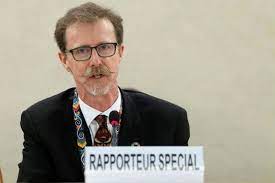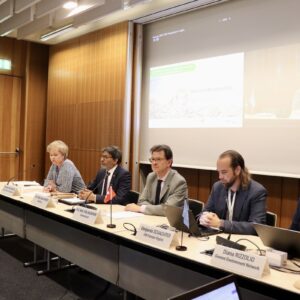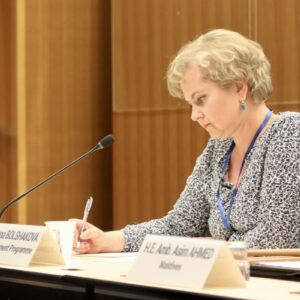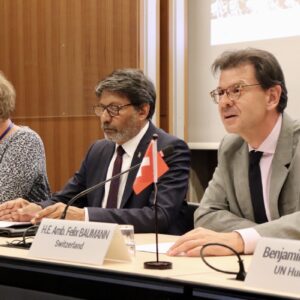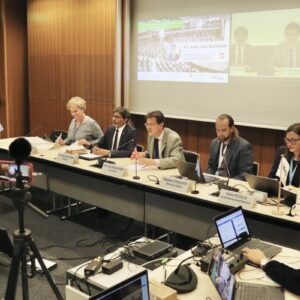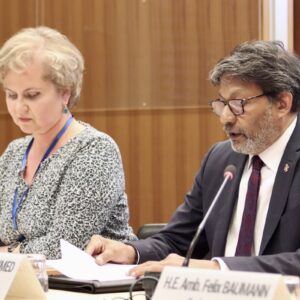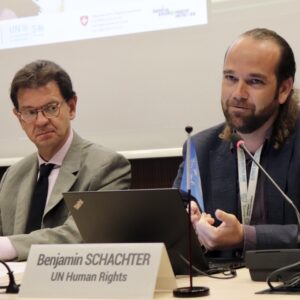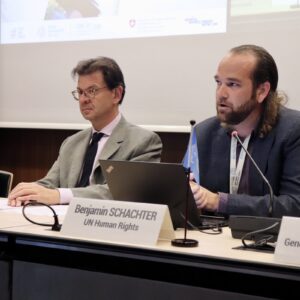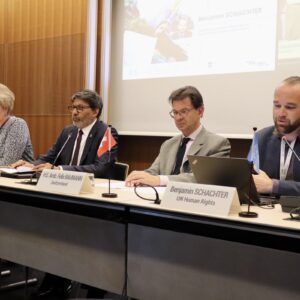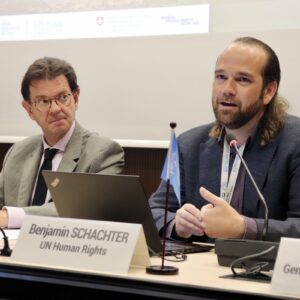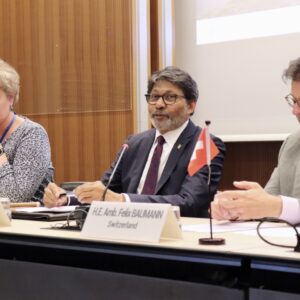Event Conference
Celebrating the Right to a Healthy Environment: 50 Years of the Stockholm Declaration
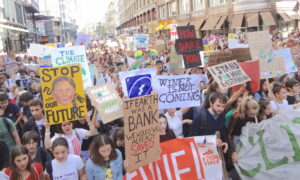
30 May 2022
16:00–17:30
Venue: International Environment House II & Online | Webex
Organization: Switzerland, Geneva Environment Network
In the lead-up to the milestone gathering of world leaders at Stockholm+50 on 2-3 June and on the occasion of World Environment Day taking place on 5 June, this event organized by Switzerland and the Geneva Environment Network celebrated the historic yet timely decision by the Human Rights Council recognizing the right to a clean, healthy, and sustainable environment, and discussed the road to the UN General Assembly.
About World Environment Day
In 1972, the UN General Assembly designated 5 June as World Environment Day (WED). The first celebration, under the slogan “Only One Earth” took place in 1974.
This year, the WED global campaign follows the same slogan, calling for transformative changes to policies and choices to enable cleaner, greener, and sustainable living in harmony with nature. It will focus on the need to live sustainably in harmony with nature, and our possibilities for shifting to a greener lifestyle through both policies and individual choices. Fifty years on, the motto is as pertinent as ever – this planet is our only home, and humanity must safeguard its finite resources.
About this Session
On 8 October 2021, the Human Rights Council for the first time recognized in a historical resolution the human right to a clean, healthy, and sustainable environment. The recognition comes at a time when our planet is facing a triple planetary environmental crisis. The impact of climate change, the pollution of air, land and water, and the resulting loss of biodiversity are negatively impacting the full and effective enjoyment of all human rights and jeopardizes the achievement of the Sustainable Development Goals (SDGs). The right to a clean, healthy and sustainable environment is critical as it has the potential to improve the life of everyone on the planet.
On 2-3 June 2022, the Stockholm+50 high-level international meeting will commemorate fifty years since the adoption of the 1972 Stockholm Declaration. As the concept of the right to a healthy environment is rooted in this major milestone, this event is also a timely occasion to celebrate and welcome the United Nations Recognition, while identifying the urgent actions necessary for its implementation.
This session was the occasion to celebrate World Environment Day a few days ahead of the official date and of official celebration in Stockholm, where the world is meeting to advance the global environmental agenda.
Speakers
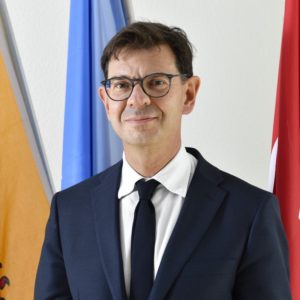
H.E. Amb. Felix BAUMANN
Deputy Permanent Representative of Switzerland to the UN Office and other international organizations in Geneva, and Permanent Representative of Switzerland to the Conference on Disarmament

H.E. Amb. Asim AHMED
Permanent Representative of the Republic of Maldives to the United Nations Office and other international organizations in Geneva
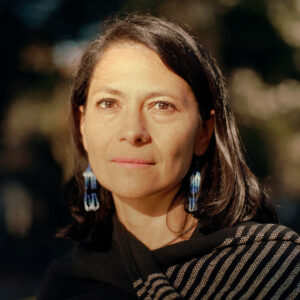
Astrid PUENTES
Environmental Lawyer, Specialized in Human Rights

Benjamin SCHACHTER
Human Rights Officer and Environment team leader, Office of the High Commissioner on Human Rights

Sierra LEDER
Advocacy Strategist, B Team

Samia SHELL
Environmental Justice and Human Rights Advocate and Law Student

Marianna BOLSHAKOVA
Regional Coordinator, Environmental Law and Governance, UNEP Europe Office | Moderator
Video
Summary
Welcome and Introduction | From the Stockholm Declaration to the adoption of the Right to a Healthy Environment
Marianna BOLSHAKOVA, Regional Coordinator, Environmental Law and Governance
We are here today as i we celebrate 50 years of advancement in international environmental governance. Fifty years ago, in 1972 in Stockholm, countries got together for the first time to recognize the environment as a global issue that needed to be addressed. At the Conference, countries adopted a declaration which stated that
“[…] Man has a fundamental right to freedom equality and adequate conditions of life in an environment of a quality that permits a life of dignity and well-being, and he bears the solemn responsibility to protect and improve the environment for present and future generations.”
Already then, we were forward-looking to the problems that we are facing today.
This Conference influenced legal and institutional development for the next decades and the creation of the UN Environment Program. The 1972 Stockholm Conference was also a starting point for the development of a series of environmental agreements and processes that guide our work today at the international level.
Twenty years after the Stockholm Conference, in 1992 in Rio, a series of treaties that deal with climate, biodiversity loss, desertification and other issues were put in place. The declaration adopted in Rio also defined the core principles that guide international environmental law and governance today. It may not have defined environmental rights as such, but it gave birth to a lot of processes that started that recognition, including the Aarhus Convention of the Pan-European region, and the Escazú Agreement that was recently developed in Latin America.
Since the 1972 Stockholm Conference, various steps took us forward in recognizing environmental rights in national constitutions. However, this progress has been slower at the international level, and interestingly enough, in the absence of this regulatory framework, courts stepped in and used their creativity to define the links between fundamental rights and the growing environmental problems by relying on the international framework of the right to life, right to privacy, right to property and so on.
Nevertheless, issues keep coming back because the impact of environmental degradation and the triple planetary crisis on the present and increasingly on future generations is more and more serious and evident. In response, some actions were recently taken at the UN level and the UN Secretary-General recently called for action on human rights, addressing issues of climate and human rights; the situation of environmental defenders and the rights of future generations.
Moreover, the big breakthrough occurred last year with the adoption of the declaration recognizing the Right to a Clean, Healthy and Sustainable Environment by the Human Rights Council (A/HRC/RES/48/13). That recognition is non-binding, thus still in the process to be fully implemented and operational within the human rights framework. It shows we are on the right path and just need to move faster because millions of lives and livelihoods, and future generations depend on this.
It is fundamental the General Assembly formally recognizes this right. Events like today’s are important steps on that path and as UNEP’s Executive Director Inger Andersen stated last week,
The right to a clean and Healthy Environment matters because it compels governments, businesses and institutions to respect, protect and fulfill that right. Enforcing this right could change so much. It could reduce which affects human health and is a significant cost to health systems. It could protect environmental defenders and indigenous people from persecution. It could make our cities more livable… Guaranteeing the right to a clean and healthy environment could change everything.
Welcome and Opening Remarks | Paving the Way for the General Assembly
H.E. Amb. Felix BAUMANN, Deputy Permanent Representative of Switzerland to the UN Office and other international organizations in Geneva, and Permanent Representative of Switzerland to the Conference on Disarmament
It is a tradition in Geneva to celebrate World Environment Day in the International Environment House. This is a landmark week as we celebrate the 50 years of the Stockholm Declaration. The work leading to Stockholm started in Geneva in the early seventies, which in turn commended the premises for the recognition of the Right to a Clean, Healthy and Sustainable Environment.
The imminent threat we are facing and which needs everyone’s full attention and action is the triple planetary crisis of climate, pollution and biodiversity loss. As time is running out, we need to act now to protect people and nature.
Ever since the first Resolution on Human Rights and the Environment in 2011 (A/HRC/RES/16/11), the Human Rights Council has built the international community’s consensus that environmental protection and the protection of human rights cannot be achieved without each other. This also reflects the interdependence and indivisibility of human rights, which Switzerland promotes at national and international levels.
In recent years, humanity has been facing unprecedented challenges in the face of environmental degradation. This causes challenges as to how can the right to water be guaranteed when global warming increases droughts in numerous regions of the world; how to deal with the vicious circle between our food system and biodiversity loss as they negatively affect one another. Again, environmental degradation in the form of air pollution makes it more challenging to grant the right to health.
These issues need to be addressed; the world is waiting for answers. The human rights system can be part of the solution and this is why the UN Secretary-General, various UN agencies, special reporters and more than 1,000 civil society organizations have called for the universal recognition of a Human Right to a Clean, Healthy, and Sustainable Environment.
After broad consultations and intense negotiations, a core group comprised of Costa Rica, the Maldives, Morocco, Slovenia and Switzerland introduced a Resolution in the Human Rights Council in October last year, recognizing this right for the first time at the global level. The Resolution was co-sponsored by 78 states and represents an international milestone for human rights and environmental law. Despite not being legally binding, it sends out a very important political signal: the international community agreed to respond to the growing impact of environmental degradation on human rights. [Learn more about the historic moment at HRC48.]
This milestone is not the end of the story. The scope and extent of the Human Rights to a Clean, Healthy and Sustainable Environment must be defined, as well as its meaning in those countries or constituencies where it is already recognized at the national and/or regional levels. Again, the implications of the UN recognition of the Right both nationally and internationally are to be defined.
To that end, Switzerland together with Lichtenstein and the Universal Rights Group organized a retreat close to Geneva, the so-called Glion Human Rights Dialogue 2022 (‘Glion VIII’) from 16 to 17 May 2022. More than 60 representatives of states, international organizations, NGOs and experts took part in this retreat. The topics discussed were the scope of the Right, its impact where it was already recognized in legislation, and what the Human Rights Council and more generally the UN system recognition could mean in the future.
The discussions helped to better understand the Right and to brainstorm on its future. Some participants argued that the scope of the Right was already quite clear as it was based on years of research, of interpretations by treaty bodies and also by special reporters, by national practices and other legal instruments, while others questioned the value of the right recognized by the Human Rights Council as its scope is still unclear.
Nevertheless, most participants agreed that the Glion Human Rights Dialogue 2022 helped to further clarify its scope; a trend that certainly would continue with a recognition by the UN General Assembly. Therefore, the core group that pushed for the recognition of the Right at the HRC last October is now in the process to submit it to the UN General Assembly.
I am confident that informal exchanges like today’s are essential to consider the various questions related to the Right to a Clean, Healthy and Sustainable Environment and to bring its recognition forward.
H.E. Amb. Asim AHMED, Permanent Representative of the Republic of Maldives to the United Nations Office and other international organizations in Geneva
In a few days, the Stockholm+50 High-Level International Meeting will commemorate 50 years since the adoption of the 1972 Stockholm Declaration. This is a truly momentous occasion as the Conference on the Human Environment held in Stockholm in 1972 made the environment an urgent global issue for the first time.
Over the last 50 years, we have learned much about the nexus between the environment and human development. Today the world is facing the triple planetary of climate change, pollution and waste, and biodiversity loss. We are also increasingly cognizant of the interlinkages between the environment and human security where habitat loss, food insecurity and poverty have important implications for the achievement of the SDGs.
Climate change is one of the greatest threats to the full enjoyment of human rights, due to its devastating impacts on lives and overall well-being. In the Maldives, we live under the constant threat of climate change. Back in 1989, with the assistance of the Commonwealth Secretariat and the Australian government, the Maldives hosted the first-ever Small States Conference on Sea-Level Rise. Bringing together several Small Island Developing States (SIDS), the Male declaration on Sea-Level Rise and Global Warming. This declaration warned already in 1989 that sea-level rise could cause considerable damage to the land and infrastructure of these countries and threaten the very survival of some island states. The Male’ Declaration laid the foundation for the formation of the Alliance Of Small Island States (AOSIS).
In 2008, our current foreign minister H.E. Abdulla Shahid, in his address at the High-Level Segment of the 70th of the Human Rights Council, asked for the negative impacts of climate change on the full enjoyment of human rights to be analysed (Maldives Submission under Resolution HRC 7/23). This led like-minded states to establish the mandate of the Independent Expert on Human Rights and Environment, later Special Rapporteur on the issues of Human Rights Obligations Relating to the Enjoyment of a Safe, Clean, Healthy and Sustainable Environment.
His excellency Abdulla Shahid, acting as the current 76th President of the UN General Assembly, reminds us that climate change is not a distant threat, but a crisis on our doorstep. This has been done for instance through the high-level thematic debate “Delivering Climate Action for People, Planet and Prosperity”, centred on the urgency of scaling up climate action to achieve the 1.5°C target and ensuring that climate change remains the highest priority on the international agenda.
Last year at HRC48, we made history. The Maldives was a proud lead co-sponsor of the landmark Resolution 48/13. The Resolution also calls on governments to continue to discuss the issue at the UN General Assembly. By recognizing this right, the general assembly could catalyze more ambitious and coordinated action to protect the environment. While we seek to accelerate climate action, it is important to note the critical need to provide the requisite resources to address the growing environmental challenges.
In this regard, the lack of adequate funding and the delay of the global financing targets for developing countries needs to be highlighted. A debt crisis threatens developing countries that lack the financial reserves to implement a greener and more resilient recovery from the COVID-19 pandemic. National governments and all relevant stakeholders, including the private sector, need to review the existing financial architecture and develop a comprehensive approach to mobilize commitments for climate financing. Achieving these targets is crucial to ensure that the right to a healthy environment is fulfilled.
We reiterate our belief that a clean, healthy, and sustainable environment is integral to the full enjoyment of human rights. The second part of the Sixth Assessment Report, Climate Change 2022: Impacts, Adaptation and Vulnerability by the IPCC urges more concerted effort on the multilateral front. As the Report highlights, science is clear. Human-induced climate change is causing dangerous and widespread disruption in nature and affecting the lives of billions around the world.
Despite efforts to reduce the risks, people and ecosystems least able to cope are being hardest hit. SIDS suffer disproportionately from the damaging impacts of climate change and have been advocating for at least a decade for the establishment of 1.5°C as the upper limit for global average temperature increase. The IPCC report highlights that limiting global warming to 1.5°C, rather than 2°C above pre-industrial levels, would make it much easier to achieve many aspects of sustainable development. This key finding underlines the urgency for climate action while focusing on equity and justice. The report is clear and underlines the fact that we must redouble our joint efforts to limit global warming.
SIDSs like the Maldives are increasingly vulnerable to climate change and its negative impacts. In that regard, the Maldives want to lead by example and thus put forward an ambitious plan to reach net-zero emissions by 2030. As part of our renewable energy strategy, we are also partnering with international renewable agencies to promote renewable technologies. In addition, the Government has prohibited the importing, manufacturing and marketing of single-use plastics within the country. We are implementing targeted holistic climate policies in recognition of the existential threat that climate change poses to the Maldives. Additionally, Maldives is proud to be the first developing country to phase out hydrochlorofluorocarbons (HCFCs), a milestone achieved 10 years ahead of the Montreal Protocol Target.
In conclusion, it is important to reflect on international solidarity, inclusivity and cooperation to save our planet and achieve the SDGs. Adequate funding, technology transfer, political commitment and partnership lead to more effective climate change adaptation and mitigation policies and programs. The time is now for global action and we must work together to leave no one behind and help to achieve everyone’s aspirations for a better, more sustainable paradigm of development and realize the Right to a Clean, Healthy and Sustainable Environment for all.
The Right to a Healthy Environment
David BOYD, Special Rapporteur on human rights and the environment
We live in a time of great peril and great promise: triple global environmental crisis of climate disaster, biodiversity, collapse, and pervasive pollution, and, at the same time, historic recognition of everyone’s right to live in a clean, healthy, and sustainable environment by the HRC and with a resolution coming from the UN General Assembly in weeks ahead.
In addition, UN Secretary General Antonio Guterres will be travelling to Stockholm+50 to urge states to embrace and act upon everyone’s Right to Environment. We have spent five decades debating the existence of this fundamental human right. That debate is now over and it is time to move on with the even greater challenge: implementation.
We are currently living a time of great excitement about the Right. The Post–2020 Global Biodiversity Framework and the proposed UN treaty on Businesses and Human Rights contain explicit reference to the Right. [The draft is now on its third revision. Learn more on the Binding Treaty.]
There is also a proposal for a New Protocol to the European Convention on Human Rights to recognize everyone’s right to a healthy environment, while preliminary discussions in Africa and Asia debate on potential regional agreements similar to the Aarhus Convention and the Escazú Treaty. We have the proposal for a new global treaty to deal with the scourge of plastic pollution. The forthcoming case at the Inter-American Court of Human Rights will be the first time that a court tackles directly the issue of pollution and the right to a healthy environment.
We live in a time where scientists are telling us we need to make transformative changes in order to achieve a sustainable future. The Right to Environment can be a very powerful tool in catalyzing transformative changes around the world people are already using this tool.
- In Chile, a new constitution is under draft and it will not only recognize the right to a healthy environment, but, if ratified, it will be the first constitution in the world to specifically refer to the right to breathe clean air.
- The Right has been used successfully to hold governments accountable for improving air quality in South Africa, in Chile, in Indonesia, and others.
- In relation to water pollution, the Inter–American Commission recently issued several judgments requiring states to address water pollution because of violations of the right to a healthy environment.
- When it comes to nature and biodiversity, the number of states phasing out both highly hazardous pesticides and the bee killing neonicotinoid pesticides are increasing.
- In terms of biodiversity and healthy ecosystems, recent judgments in South Africa and Argentina managed to protect endangered marine mammals from the impacts of offshore oil and gas development.
- In Ecuador where a group of nine young girls used their right to a healthy environment to stop the flaring of oil and gas near their communities in Ecuador.
Finally, the Right to a Clean, Healthy, and Sustainable Environment also includes non-toxic environments. There are simply too many sacrifice zones around the world where people are being exposed to horrible levels of pollution and toxic substances. Progress on cleaning up some of these sacrifice zones are taking place in Canada, Zambia, the USA, Chile and Argentina. [Learn more on the report by SR Environment on “sacrifice zones” at HRC49.]
Therefore, we must ensure that Right to a Clean, Healthy, and Sustainable Environment is used by as many people as possible. This can fulfil its goal to help achieving a just and sustainable future, where we all live in harmony with nature on this beautiful blue green planet.
Recognition of the Right to a Healthy Environment for Environmental Human Rights Defenders and tackling the Triple Planetary Crisis
Astrid PUENTES, Environmental Lawyer, Specialized in Human Rights and Climate Change
When talking about the recognition of the Right to a Clean, Healthy and Sustainable Environment, it is important to start from reality. We must remember that the recognition is very important amidst the triple crisis we are facing. In legal terms, this recognition is per se a step forward but the important thing its applicability.
Another layer to be added, especially from the Latin American perspective, is the protection of environmental defenders. In the Global South, environmental defenders face difficult situations in several countries. As such, the recognition of the Right also entails recognition and protection of their contributions to safeguard the earth.
The recognition of the Right to a Clean, Healthy and Sustainable Environment is important also in terms of inequality.
- The triple crisis is embedded with inequalities because indigenous and disadvantaged peoples are the ones that are suffering the most from it, despite being the least responsible for the crisis.
- Additionally, the recognition is important because current solutions to the triple planetary crisis are not appropriate to solve it all while protecting our human rights. By granting everyone the right to be safe while protecting the environment, efforts can be multiplied and solutions advanced. This will allow to change course and produce the improvements.
- Lastly, the importance of this Right has been already demonstrated from the ground as more 350 organizations and movements worldwide called for its recognition.
Therefore, it is now up to the General Assembly to allow for this tool to be used in all territories.
Unfortunately, human rights and the environment have been treated as two separate planets, while we have only one planet. In the past 15 years human rights, legal frameworks, and even institutions sometimes have been separated from environmental ones.
However, our single planet is deeply connected, and we must act in coordination on all fronts and put in practice the key principles from of human rights: interdependency, indivisibility, and universality of all human rights. This is a pending step necessary for the recognition of the Right to a Healthy Environment, as it helped significantly in several countries and regions where the human rights are healthy environment has been recognized. The realities on the ground call for this recognition and this is the time to do it, because it will give us additional tools to embrace solutions and curb inequalities and injustices.
Recognizing this right means granting environmental defenders, communities, indigenous peoples, Afro-descendant peoples, women, children, youth tools they can use to effectively protect their human rights.
Celebrating Right to a Healthy Environment as we Launch Stockholm+50
Benjamin SCHACHTER, Human Rights Officer and environment team leader, United Nations Office of the High Commissioner for Human Rights
Picking up on certain points mentioned, Ben Schachter emphasizes on some of the priorities of OHCHR regarding the right to a healthy environment.
I want to thank Switzerland and Maldives for their leadership along with the other members of the core group in bringing Human Rights Council resolution 48/13 to fruition. We hope that’s not the end and that the process continues at the UN General Assembly.
We also want to make it very clear that we all have the human right to a clean, healthy, and sustainable environment. Irrespective of what happens in these bodies because human rights are indivisible, inalienable, interdependent, and there are things that we inherently possess by virtue of being human beings.
The act of recognition triggers a lot of potential and catalyzes a lot of opportunities for implementation and so the act of recognition is important. HRC 48/13 was a fantastic step in that direction, but we all know and inherently recognize that we have a human right to a healthy environment. Nobody can take that from us.
On Stockholm+50. The Stockholm Declaration has been an important inspiration for the work of the office on human rights and the environment but efforts to realize the vision of Stockholm have been uneven and cases insufficient. In some countries, strong laws and policies backed by robust accountability mechanisms, protect the environment more effectively than in others where such protections are lacking. However, some of them are essentially exporting their environmental harms and impacts. As such, there’s no country doing enough. There’s no government that’s doing enough to protect the environment, and all of us as individuals also have a lot more work to do.
The last fifty years have revealed more than ever the global nature of environmental crisis. The negative human rights consequences that disproportionately affect those already in vulnerable situations within and across countries, critical environmental protections are not equally enjoyed by all.
This has spurred a vast movement for change, as seen in the call by civil society and indigenous people’s representative organizations for the recognition of the human rights to a healthy environment. It is a movement and it’s a movement that we can’t afford lose momentum towards its implementation.
OHCHR, working with UNEP and other partners, has been working to support this recognition and its implementation. We stand up for rights holders around the world, demanding environmental justice, and the fulfillment of their right to a healthy environment. But there are a lot of obstacles including entrenched special interests, placing profit before people, unsustainable consumption and production, and inadequate legal and accountability frameworks.
There have been successes, including integration of human rights in the Paris Agreement on climate change, adoption of the Escazú Agreement in Latin America. Modern and social sciences have brought us an improved understanding of environmental challenges needed to adequately address environmental harms, as seen in the AR6 WGII report of the IPCC, where the report clearly states that human rights based approaches lead to more effective outcomes.
We have done a lot, but we’re nowhere near where we need to be to protect human rights from the triple planetary crisis. Stockholm+50 represents a critical moment for a continuation of the discussion, and we have a road map for action: the 2030 Agenda, the Paris Agreement, and other instruments and human rights law represent an agreement by States and people to a transformative vision for people development. We just have to realize it. We must put the resources behind it that are needed. We must move toward strengthening partnerships within the UN system.
The Secretary General’s call to action for human rights, Our Common Agenda, and the work of the UN Environment Management Group are all increasingly focusing on issues related to human rights and environment and bringing the UN system together to work in this area.
- There is a Stockholm+50 side event that OHCHR and partners are co-organizing called “Coming Together for Healthy People and a Healthy Planet: The UN system’s commitment to advancing the human right healthy environment”, taking place on 2 June. The event brings together voices you’ve heard and voices from across the UN system, youth, and indigenous people’s representatives, among others to talk about some of these critical issues.
Conclusion. We need to move towards implementation and integrating human rights more effectively in environmental processes. As David mentioned, in the post-2020 global biodiversity framework, there are a number of references to human rights and the right to a healthy environment in the draft negotiating text. These are all in brackets. For States to be coherent and consistent with with the positions they’ve taken, we need to get the brackets off. We need to have a biodiversity framework that respects, protects, and fulfills human rights. Mariana also mentioned the UNFCCC one where OHCHR has been engaged for a long time.
There’s a lot of work that needs to be done to integrate human rights and nationally determined contributions under the UNFCCC, National Biodiversity Strategies and Action Plans to walk the talk on the human right to a healthy environment and a human rights-based approach to the triple planetary crisis. All this will require more effective international cooperation and mobilization of resources, and this is difficult and challenging work we have ahead of us, but we already have laid the groundwork to make substantial progress.
Business and the Right to a Healthy Environment
Sierra LEDER, Advocacy Strategist, B team
The B Team is a global collective of business and civil society leaders working to create new norms of corporate leadership today, for a better tomorrow. We recognize the work that lies before us, including fully understanding the implications of recognizing and implementing the right in policy and legal tracks, and the need for continued support ahead of the tabling of this resolution at the UNGA. We believe that this movement is both timely and necessary.
Before last year’s initiative for a resolution at the Human Rights Council, the business voice had largely been silent on this issue, with no clear position – and in some cases this was even taken as indication of opposition.
- In partnership with our business leaders, Business for Nature, and the World Business Council for Sustainable Development, the Business Statement calling for adoption of the resolution was designed to show the support of business for universal recognition of the human right and to complement existing statements from civil society and the UN agencies.
- A concerned business voice on this issue is critical and can make a difference, hence the Business Statement, and that beyond UN recognition, business will play a key role and be a key partner in implementing this right.
The rationale for business support of this right is clear, as business is a stakeholder in both healthy environments and thriving communities.
- The Business Statement today has over 50 signatories, including major multinationals such as Unilever, Salesforce, Safaricom, Natura & Co, Allianz, H&M, Adidas, and Ingka Group, which includes the core IKEA Retail business. Some were not yet ready to sign on publicly but overall, we have heard positive support for the resolution and this work.
- There is increasing recognition of business as a major player in society, not just in economics – and on the flip side business relies on natural capital and healthy societies to be able to operate sustainably in the long term.
Recognizing this right at the UN General Assembly will function as a global tool to protect our natural capital and create the conditions through which our planet—and business—can sustainably thrive and prosper.
- The business case is clear. Businesses rely on nature for resources such as food, fiber, minerals and building materials; ecosystem services such as pollination of crops, water filtration, waste decomposition, climate sequestration and climate regulation; and healthy and prosperous societies that give them their customers and workforces.
- Business is also increasingly recognizing the connections between the environment and social aspects such as human rights. The concept of a just transition is a clear example of this and has been at the forefront of conversations about how climate change impacts the most vulnerable, for example in the energy transition.
The realization of targets contained within the Sustainable Development Goals and other major agreements requires the steadfast commitment of the business community, and we are rising to that challenge.
The right to environment is part of a new social contract and a refreshed framing of climate objectives, and will also be a key tool in engaging with the new climate-focused generation – today’s youth and generations to come.
- The SDGs, the UNGPs, and due diligence processes – both mandatory and voluntary – are key to ensuring a sustainable, resilient future for all. The UNGA recognition would create a systemic integration to link and anchor different actors in the rights and environmental spaces.
- Practical implementation is also at the forefront of business thinking, and there is a role for business in setting up sustainable practices and precedents. This includes due diligence practices, circular business models, leading social and cultural tone-setting for the “climate generation”, as well as providing expertise and practical knowledge during the development of guidance and regulations.
- Business should also be a partner in collaborative action alongside governments and civil society. Business knowledge and tools for respecting human rights, now including the right to a healthy environment, can demonstrate best practices as an example to other businesses, and to the public sector where applicable.
- One important method, due diligence, is a crucial element of ensuring respect of the human right to a healthy environment.
- The burden of costs and efforts to respect this right should not be passed from large companies to SMEs, whether in the value chain or in working relationships. All businesses have the responsibility to respect human rights, including this newly recognized right.
A General Assembly resolution on the right to a healthy environment would serve as an important catalyst to protect global natural capital and to create the conditions through which business and communities can thrive sustainably.
- From a stakeholder perspective, General Assembly recognition would also provide a universal impetus for action, as well as a tool for action. This recognition would be a globally-agreed reason to respect the right to a healthy environment – beyond the evident moral imperative – and would also be a tool by which to organize collective action and mobilize resources.
- The General Assembly recognition of this right is also a mechanism for accountability.
Conclusion. The human right to a clean, healthy and sustainable environment is fundamental to the functioning of our businesses, our societies, and our economies.
- As our business statement says, we are committed to this common work. We recognise and highlight that the realisation of targets contained within the Sustainable Development Goals, the Convention on Biological Diversity and the Paris Agreement requires the steadfast commitment of the business community and we are rising to that challenge.
- We stand alongside states, civil society organisations, environmental defenders, and UN entities calling for General Assembly recognition of the right to a healthy and sustainable environment, so we can ensure that no one is left behind in a just transition to an equitable, nature-positive and carbon neutral world.
- We wish to express our support for this forthcoming resolution at the General Assembly and for future efforts to respect the human right to a healthy environment, and offer thanks to you all for your commitment to serve the best interests of present and future generations.
The Future
Samia SHELL, Environmental Justice and Human Rights Advocate and Law Student
For Samia Shell’s full statement, please visit the Children’s Environmental Rights Initiative page. Here are some highlights from the statement.
I am not here to discuss the present. I am here on behalf of our future… Because of the endurance [of my ancestors], I am here today. I and countless others across this planet are here to let it be known that each of us deserves a clean, safe, and healthy environment. In the face of the challenges [the triple planetary crisis], we too, possess the courage and motivation necessary to secure a livable and better future for our children, youth, and future generations.
Children and youth have played an instrumental role in protecting our right to a healthy environment, and in catalyzing radical change for our planet and people. Youth are challenging the very constitutions and statutes that make up the fabric of our societies, and are holding our governments to account for their duties arising under the Paris Agreement and other conventions to protect our rights to a clean, safe, and healthy environment today, and for future generations.
While, children and youth have met this unprecedented task of advocating for all people, living, and nonliving things, the stark inequality of this burden compared to the fact that we are not responsible for creating these issues must not be overlooked… Adopting the right to a healthy environment will allow for redress of current harms, increase children and youth’s access to participation in decision-making processes, and will prevent further harm from affecting our growing human family.
Almost 50 years ago, youth were present at Stockholm, and helped to enshrine the body of law that we now appreciate today to protect environmental rights. With Stockholm again ahead of us along with World Environment Day, it is prime time to recall our forward-looking wisdom: that tomorrow, things can be different. They will be different.
Discussion
To be continued.
Q: When we say catalyze the action, how do you see the role of different duty bearers?
It is clear from all what you’ve said that now the challenges implementation is action. Since HRC adopted this resolution, trade-offs have not disappeared, special interests have not disappeared. How do you see the role of the different layers in policy making? What will be most challenging and where do you see the most hope for translating this newly recognized right into action? — Pascal Deslisle, EU delegation to the UN in Geneva
Benjamin SCHACHTER: OHCHR has dedicated substantial time and analysis in deriving the basic human rights obligations that apply in different environmental situations. What kinds of human rights obligations apply in the context of biodiversity laws? In the context of climate change? We have our key message documents on our website.
There are a few main cross-cutting themes the triple planetary crisis posing as real challenges for action and implementation: resource mobilization, awareness and knowledge and capacity. They include to a great extent failures related to participation, access to information, and access to justice and protection of environmental human rights defenders. There are many things we must do. Fundamentally, if we do not include the voices of the people affected in decision making processes, if we’re not ensuring an accountability mechanism that works so that people harmed by environmental crisis have some recourse then we’re not going to be able to address this crisis.
We can conceptualize and understand in the abstract that this is a crisis, but I don’t think we realize that we’re already in it. The challenge there is that it’s not real to enough people. It’s real to the people who are already being affected and seeing their lives change. But we need to make it real to everybody. The fact that the people and governments with the most power and capacity for change may not be experiencing the impacts of environmental harms the same way others are shows that we need to address that divide in our work to reduce and tackle inequalities.
Sierra LEDER: There is a global shift towards standards for corporate disclosure on environmental, social and governance issues. The nascent movement towards mandatory human rights and environmental due diligence is also important. A common standard as well as a level playing field for regulations for everybody to be operating in the same way is also very important. Um I’m sure that a lot of you have heard about the new initiative of the International Sustainability Standards Board. I think their work will be important in making sure that there is an information flow on topics like this.
Q: Would you be able to elaborate on the reaction between the right two healthy environment and environmental justice?
Samia SHELL: The right to a healthy environment is the the baseline, the foundation of the concept of environmental justice and as an extension of climate justice. If we don’t believe that people are entitled to a healthy environment or a clean and safe environment, then it is impossible to implement or secure environmental justice and climate justice for all people.
The important piece of environmental justice is the concept of inequity, of burdens being disproportionately held on some while benefits are being disproportionately enjoyed by others. Another prong is participation and decision-making processes, being able to exercise sovereignty over your own community and the things that affect your local environments. The third prong is access to justice, access to address, and recourse for current past wrongs. Ensuring that we have a right to a healthy environment enshrined in the law into something actionable will protect the ability to go to actual court or in other forums to secure environmental justice.
In terms of climate justice, the idea that some countries are bearing the burdens of the climate crisis as opposed to others that are not bearing those burdens but are instead contributing disproportionately to the same flows. That climate justice is possible as a result of acknowledging that everyone is entitled to a healthy environment.
Q: Do the States representatives present today expect the General Assembly to take action before the end of the ongoing session?
Last week, the UN Secretary General stressed again the need for the General Assembly to take urgent action in response to the resolution adopted last year at the Human Rights Council. So as to facilitate implementation and building upon the leadership of the core group here in Geneva, what can we expect from the ongoing session? — Sebastian Duyck, CIEL
H.E. Amb. Asim AHMED: As I understand from my colleagues in New York, they are working on a draft of the resolution. We are hoping that they will try to pass it before the current session ends. There is a long and difficult negotiation in the GA everyone in the GA is a voting member as opposed to the HRC. So, the negotiations are likely to be much more complex. I think everyone understands that we need to keep the momentum.
H.E. Amb. Felix BAUMANN: The current stage beyond the negotiation is important to have a thorough outreach as seen in Glion. We have seen the support of many States, civil society, and business who have shown their readiness and support to assist the core group. It’s important to reach out to them and see how we can harness their support.
Comment from Yves Lador, Earthjustice
I just want to take the opportunity having the ambassador of the Maldives with us to say how much we at the NGO community wish that the confirmation or acknowledgement that the UNGA will be taken under the country’s chairmanship because it will carry a very strong meaning. We need this to be adopted very quickly and we need this to be adopted now. If I’m correct, the NGOs in New York have asked the core group for a meeting on 9 July.
We also hope for the the Geneva-based community to be able to follow this discussion and have a common strategy between the core group and the NGOs in New York and Geneva. In Latin America, there have been some interesting developments. Perhaps experts from the region could tell us and give us some of the most recent development that happened at the level of the inter-American court on human rights because it is interesting to see how human rights courts are making very important progress in defining what the human rights are in the climate change context, but also as part of the right to a healthy and sustainable environment.
Closing Remarks
H.E. Amb. Felix BAUMANN: Today’s discussion has shown broad support that that that we enjoy. The moment now is to capitalize on this outreach to civil society, business and the youth. This is important to continue the discussions in an inclusive manner.
H.E. Amb. Asim AHMED: We have underscored the importance of environmental rights for achieving sustainable development. We have also underscored the importance of interlinkages between environmental rights and other development issues, particularly focusing on issues of environmental justice and environmental rights. The issue of youth is also important because this whole issue is about the future, and not only about the present. We all hope that the resolution will be passed by the GA soon as that would further consolidate the right to a safe, healthy and sustainable environment.
Documents
Gallery
Links
- Special Rapporteur on Human Rights and the Environment Press Release | 30 May 2022
- Stockholm+50 Official Website
- Stockholm+50 & Geneva | GEN Update
- World Environment Day Official Website
- World Environment Day | GEN Update
- Human Rights and the Environment | GEN Update
Credit
Climate protest and student strike in Geneva on Friday, 27 September 2019. Rues basses | Wikimedia Commons | MHM55

